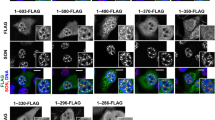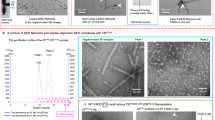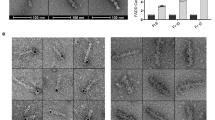Abstract
Death effector domain-containing proteins are involved in important cellular processes such as death-receptor induced apoptosis, NF-κB activation and ERK activation. Here we report the identification of a novel nuclear DED-containing protein, FLAME-3. FLAME-3 shares significant sequence (46.6% identical) and structural homology to another DED-containing protein, DEDD. FLAME-3 interacts with DEDD and c-FLIP (FLAME-1) but not with the other DED-containing proteins FADD, caspase-8 or caspase-10. FLAME-3 translocates to, and sequesters c-FLIP in the nucleus upon overexpression in human cell lines. Using the yeast two-hybrid system to identify DEDD-interacting proteins, the TFIIIC102 subunit of human transcription factor TFIIIC was identified as a DEDD- and FLAME-3-specific interacting protein. Co-expression of either DEDD or FLAME-3 with hTFIIIC102 in MCF-7 cells induces the translocation from the cytoplasm and sequestration of hTFIIIC102 in the nucleus, indicating that DEDD and FLAME-3 form strong heterocomplexes with hTFIIIC102 and might be important regulators of the activity of the hTFIIIC transcriptional complex. Consistent with this, overexpression of DEDD or FLAME-3 in 293 cells inhibited the expression of a luciferase-reporter gene under the control of the NF-κB promoter. Our data provide the first direct evidence for the involvement of DED-containing proteins in the regulation of components of the general transcription machinery in the nucleus.
Similar content being viewed by others
Log in or create a free account to read this content
Gain free access to this article, as well as selected content from this journal and more on nature.com
or
Abbreviations
- DED:
-
death effector domain
- EST:
-
expressed sequence tags
- CTD:
-
C-terminal domain
References
Ashkenazi A, Dixit VM . 1998 Death receptors: signaling and modulation Science 281: 1305–1308
Weber CH, Vincenz C . 2001 The death domain superfamily: a tale of two interfaces? Trends Biochem. Sci 26: 475–481
Boldin MP, Mett IL, Varfolomeev EE, Chumakov I, Shemer-Avni Y, Camonis JH, Wallach D . 1995 Self-association of the ‘death domains’ of the p55 tumor necrosis factor (TNF) receptor and Fas/APO1 prompts signaling for TNF and Fas/APO1 effects J. Biol. Chem 270: 387–391
Chinnaiyan AM, Tepper CG, Seldin MF, O'Rourke K, Kischkel FC, Hellbardt S, Krammer PH, Peter ME, Dixit VM . 1996 FADD/MORT1 is a common mediator of CD95 (Fas/APO-1) and tumor necrosis factor receptor-induced apoptosis J. Biol. Chem 271: 4961–4965
Salvesen GS, Dixit VM . 1999 Caspase activation: the induced-proximity model Proc. Natl. Acad. Sci. USA 96: 10964–10967
Medema JP, Scaffidi C, Kischkel FC, Shevchenko A, Mann M, Krammer PH, Peter ME . 1997 FLICE is activated by association with the CD95 death-inducing signaling complex (DISC) EMBO J 16: 2794–2804
Yang X, Chang HY, Baltimore D . 1998 Autoproteolytic activation of pro-caspases by oligomerization Mol. Cell 1 319–325
Budihardjo I, Oliver H, Lutter M, Luo X, Wang X . 1999 Biochemical pathways of caspase activation during apoptosis Annu. Rev. Cell. Dev. Biol 15: 269–290
Yin XM . 2000 Bid, a critical mediator for apoptosis induced by the activation of Fas/TNF-R1 death receptors in hepatocytes J. Mol. Med 78: 203–211
Krueger A, Baumann S, Krammer PH, Kirchhoff S . 2001 FLICE-inhibitory proteins: regulators of death receptor-mediated apoptosis Mol. Cell. Biol 21: 8247–8254
Yeh WC, Itie A, Elia AJ, Ng M, Shu HB, Wakeham A, Mirtsos C, Suzuki N, Bonnard M, Goeddel DV, Mak TW . 2000 Requirement for Casper (c-FLIP) in regulation of death receptor-induced apoptosis and embryonic development Immunity 12: 633–642
Ramos JW, Kojima TK, Hughes PE, Fenczik CA, Ginsberg MH . 1998 The death effector domain of PEA-15 is involved in its regulation of integrin activation J. Biol. Chem 273: 33897–33900
Ramos JW, Hughes PE, Renshaw MW, Schwartz MA, Formstecher E, Chneiweiss H, Ginsberg MH . 2000 Death effector domain protein PEA-15 potentiates Ras activation of extracellular signal receptor-activated kinase by an adhesion- independent mechanism Mol. Biol. Cell 11: 2863–2872
Zhang Y, Redina O, Altshuller YM, Yamazaki M, Ramos J, Chneiweiss H, Kanaho Y, Frohman MA . 2000 Regulation of expression of phospholipase D1 and D2 by PEA-15, a novel protein that interacts with them J. Biol. Chem 275: 35224–35232
Condorelli G, Vigliotta G, Iavarone C, Caruso M, Tocchetti CG, Andreozzi F, Cafieri A, Tecce MF, Formisano P, Beguinot L, Beguinot F . 1998 PED/PEA-15 gene controls glucose transport and is overexpressed in type 2 diabetes mellitus EMBO J 17: 3858–3866
Stegh AH, Schickling O, Ehret A, Scaffidi C, Peterhansel C, Hofmann TG, Grummt I, Krammer PH, Peter ME . 1998 DEDD, a novel death effector domain-containing protein, targeted to the nucleolus EMBO J 17: 5974–5986
Schickling O, Stegh AH, Byrd J, Peter ME . 2001 Nuclear localization of DEDD leads to caspase-6 activation through its death effector domain and inhibition of RNA polymerase I dependent transcription Cell. Death. Differ 8: 1157–1168
Chaudhary PM, Eby MT, Jasmin A, Kumar A, Liu L, Hood L . 2000 Activation of the NF-kappaB pathway by caspase 8 and its homologs Oncogene 19: 4451–4460
Chaudhary PM, Jasmin A, Eby MT, Hood L . 1999 Modulation of the NF-kappa B pathway by virally encoded death effector domains-containing proteins Oncogene 18: 5738–5746
Hu WH, Johnson H, Shu HB . 2000 Activation of NF-kappaB by FADD, Casper, and caspase-8 J. Biol. Chem 275: 10838–10844
Zvalova D, Formstecher E, Fauquet M, Canton B, Chneiweiss H . 2001 Keeping TNF-induced apoptosis under control in astrocytes: PEA-15 as a ‘double key’ on caspase-dependent and MAP-kinase-dependent pathways Prog. Brain Res. 132: 455–467
Leo CP, Hsu SY, McGee EA, Salanova M, Hsueh AJ . 1998 DEFT, a novel death effector domain-containing molecule predominantly expressed in testicular germ cells Endocrinology 139: 4839–4848
Hsieh YJ, Wang Z, Kovelman R, Roeder RG . 1999 Cloning and characterization of two evolutionarily conserved subunits (TFIIIC102 and TFIIIC63) of human TFIIIC and their involvement in functional interactions with TFIIIB and RNA polymerase III Mol. Cell. Biol 19: 4944–4952
Huang Y, Maraia RJ . 2001 Comparison of the RNA polymerase III transcription machinery in Schizosaccharomyces pombe, Saccharomyces cerevisiae and human Nucleic Acids Res 29: 2675–2690
Geiduschek EP, Kassavetis GA . 2001 The RNA polymerase III transcription apparatus J. Mol. Biol 310: 1–26
Roth W, Stenner-Liewen F, Pawlowski K, Godzik A, Reed JC . 2002 Identification and characterization of DEDD2, a death effector domain- containing protein J. Biol. Chem 272: 7501–7508
Van Dyke MW, Roeder RG . 1987 Two forms of transcription factor TFIIIC in extracts from HeLa cells Nucleic Acids Res 15: 5031–5039
Schneider HR, Waldschmidt R, Jahn D, Seifart KH . 1989 Purification of human transcription factor IIIC and its binding to the gene for ribosomal 5S RNA Nucleic Acids Res 17: 5003–5016
Liu R, Takayama S, Zheng Y, Froesch B, Chen GQ, Zhang X, Reed JC, Zhang XK . 1998 Interaction of BAG-1 with retinoic acid receptor and its inhibition of retinoic acid-induced apoptosis in cancer cells J. Biol. Chem 273: 16985–16992
Srinivasula SM, Ahmad M, Ottilie S, Bullrich F, Banks S, Wang Y, Fernandes-Alnemri T, Croce CM, Litwack G, Tomaselli KJ, Armstrong RC, Alnemri ES . 1997 FLAME-1, a novel FADD-like anti-apoptotic molecule that regulates Fas/TNFR1-induced apoptosis J. Biol. Chem 272: 18542–18545
MacFarlane M, Ahmad M, Srinivasula SM, Fernandes-Alnemri T, Cohen GM, Alnemri ES . 1997 Identification and molecular cloning of two novel receptors for the cytotoxic ligand TRAIL J. Biol. Chem 272: 25417–25420
Srinivasula SM, Ahmad M, Lin JH, Poyet JL, Fernandes-Alnemri T, Tsichlis PN, Alnemri ES . 1999 CLAP, a novel caspase recruitment domain-containing protein in the tumor necrosis factor receptor pathway, regulates NF-kappaB activation and apoptosis J. Biol. Chem 274: 17946–17954
Lin X, Mu Y, Cunningham ET Jr, Marcu KB, Geleziunas R, Greene WC . 1998 Molecular determinants of NF-kappaB-inducing kinase action Mol. Cell. Biol 18: 5899–5907
Acknowledgements
This work was supported by National Institutes of Health Grants CA85421 and AG14357 (to ES Alnemri). SM Srinivasula is a Special Fellow of the Leukemia and Lymphoma Society.
Author information
Authors and Affiliations
Corresponding author
Additional information
Edited by G Melino
Rights and permissions
About this article
Cite this article
Zhan, Y., Hegde, R., Srinivasula, S. et al. Death effector domain-containing proteins DEDD and FLAME-3 form nuclear complexes with the TFIIIC102 subunit of human transcription factor IIIC. Cell Death Differ 9, 439–447 (2002). https://doi.org/10.1038/sj.cdd.4401038
Received:
Accepted:
Published:
Issue date:
DOI: https://doi.org/10.1038/sj.cdd.4401038
Keywords
This article is cited by
-
Influenza A virus matrix protein 1 interacts with hTFIIIC102-s, a short isoform of the polypeptide 3 subunit of human general transcription factor IIIC
Archives of Virology (2009)
-
Death effector domain DEDa, a self-cleaved product of caspase-8/Mch5, translocates to the nucleus by binding to ERK1/2 and upregulates procaspase-8 expression via a p53-dependent mechanism
The EMBO Journal (2007)
-
DEDD and DEDD2 associate with caspase-8/10 and signal cell death
Oncogene (2003)
-
The death effector domain protein family
Oncogene (2003)
-
Deadly FLAME
Nature Reviews Molecular Cell Biology (2002)



